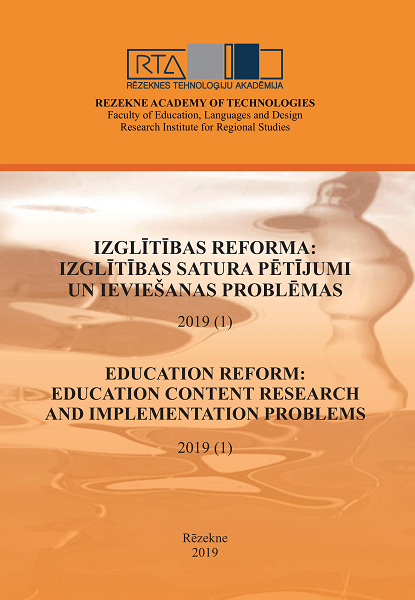ADOLESCENT’S ADDICTIVE BEHAVIOUR DECREASE OPPORTUNITIES AT SCHOOL
DOI:
https://doi.org/10.17770/er2019.1.4215Keywords:
Addictive behavior, research, questionnaire, mathematical processing of data, skillsAbstract
Prevalence of addictive behavior among young people is very rapid. Different preventive measures are being taken in schools to reduce addictive behavior, but often the youth age is the time when they want to experiment and self-testify using different intoxicants and often the form of organizing these preventive measures is not binding and effective for young people. The aim of the research is to reduce the addictive behavior of socio-pedagogical activity by developing social skills for young people. Research Methods: interviewing, questionnaires, mathematical processing of data. Mainly young people are starting to use addictive substances as a result of peer pressure, having problems with friends, out of curiosity, and family problems. However, the knowledge of the consequences discourages use of various intoxicating substances, the control of the parents, the fear and the fact that their friends also do not use. Skill, no, decision-making skills, critical thinking skills, skills to protect your opinion, and reasonable talk skills help refrain from using addictive substances.References
Ceplis, D., Liepiņa, L., Prišpetjeva, J., Rupā, T., Sūniņa, V., & Vilks, A. (2001). Bērns un kriminalitāte. Rīga: Raka.
Davis, C., Cohen, A., Davids, M., & Rabindranath, A. (2015). Attention-deficit/hyperactivity disorder in relation to addictive behaviors: a moderated-mediation analysis of personality-risk factors and sex. Retrieved from http://web.a.ebscohost.com/ehost/pdfviewer/pdfviewer?vid=4&sid=f08e3f88-da74-466a-9672-8c9b14c1f04b%40sessionmgr4004&hid=4106
Jegorovs, A. (2009). Uzvedības atkarības. Rīga: Raka.
Jirgena, S. (2006). Jaunieši un adiktīva uzvedība. Rīga: Drukātava.
Kristapsone, S.(2014). Zinātniskā pētniecība studiju procesā. Rīga: Turība.
Pazzaglia, M., Stafford, E., & Rodriguez, S. (2016). Survey Methods for Educators: Analysis and Reporting of Survey Data. Retrieved from http://web.b.ebscohost.com/ehost/detail/detail?vid=4&sid=db549b5c-538e-453e-8748-b9b092a2a713%40sessionmgr104&hid=130&bdata=JnNpdGU9ZWhvc3QtbGl2ZQ%3d%3d#AN=ED567753&db=ericsk. 22.02.2019.
Sniķere, S., & Trapencieris, M. (2016). Atkarību izraisošo vielu lietošanas paradumi un tendences skolēnu vidū. Rīga: ESPAD
Vilks, A. (2001). Deviantoloģija. Rīga: Tiesu namu aģentūra.






